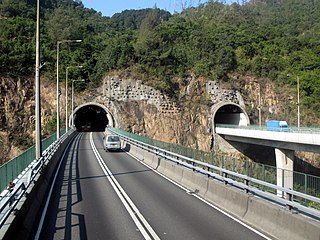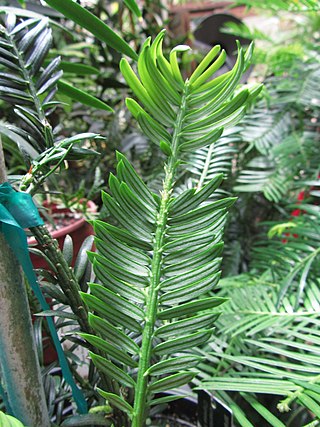
Tai Lam Country Park, established on 23 February 1979, is a country park located in Tai Lam, at the south of Yuen Long Town, Kam Tin and Shek Kong and east of Tuen Mun Town, in the western New Territories of Hong Kong. This country park has an area of 54 km².

Ma On Shan Country Park is a park located in the central neck of the Sai Kung Peninsula in the eastern New Territories of Hong Kong. The park covers an area of 28.8 square kilometres (11.1 sq mi) and links Sai Kung Country Park and Lion Rock Country Park to form an extensive recreation area on the Ma On Shan massif.

The Wilson Trail is a 78-kilometre (48 mi) long-distance footpath in Hong Kong, 63 km of which runs through Hong Kong country parks. It was named after David Wilson, Baron Wilson of Tillyorn, who was penultimate Governor of Hong Kong from 1987 to 1992. The Wilson Trail was developed by Friends of the Country Park and sponsored by various private organisations. The construction work of the trail began in 1994. The Wilson Trail was first opened on 21 January 1996.

Lion Rock Country Park is a country park, located in the New Territories, Hong Kong. It consists of approximately 5.57 square kilometres (2.15 sq mi) of land, including Lion Rock and Mong Fu Shek and their surrounding scenic hillsides, of which 3.48 square kilometres (1.34 sq mi) is forestry plantation.

Out of the total 1,092 km2 of land in Hong Kong, three-quarters is countryside, with various landscapes including beaches, woodlands, and mountain ranges being found within the small territory. Most of Hong Kong's parks have abundant natural diversity, usually containing over 1,000 species of plants.

Shing Mun Reservoir is a reservoir in Hong Kong. It is located in Shing Mun, the area between Tsuen Wan and Sha Tin, in the New Territories. Administratively, it is located within the boundaries of Tsuen Wan District.

The MacLehose Trail is a 100-kilometre hiking trail that crosses much of the New Territories, Hong Kong, starting from Pak Tam Chung, Sai Kung District in the east to Tuen Mun Town, Tuen Mun District in the west. It is the longest trail in Hong Kong and the path is marked by distance posts at 500-metre intervals. The trail is named after Murray MacLehose, Baron MacLehose of Beoch, the longest-serving governor of Hong Kong, who established the Country Parks and was himself an enthusiastic hiker. The trail passes through a variety of natural scenery including beaches and mountains.

The Shing Mun Tunnels are a system of tunnels and viaducts in the New Territories, Hong Kong connecting the new towns of Tsuen Wan to the west and Sha Tin to the east. They are a part of Route 9 and the Tsuen Wan entrance is the reset point of Route 9.

Golden Hill Country Park or Kam Shan Country Park, also known in Hong Kong as Monkey Hill, established on 24 June 1977, is a country park located in the ranges north of Kowloon, Hong Kong. It covers an area of 3.37 square kilometres (1.30 sq mi). Most of the area is covered by the Kowloon Group of Reservoirs. Inside the park, there are jogging trails, barbecue and picnic areas, which are easily accessible from Tai Po Road via waterworks access roads. The park takes its name from the 369 metres (1,211 ft) peak, Golden Hill or Kam Shan (金山), which is the highest feature in the area.

Grassy Hill is the fourteenth highest mountain in Hong Kong. Peaked at 647 m (2,123 ft), it is situated between Tsuen Wan and Tai Po and near Lead Mine Pass. Stage 7 of MacLehose Trail runs near its peak.

Lead Mine Pass is a mountain pass in the New Territories, Hong Kong. It is near Grassy Hill and two walking trails, MacLehose Trail and Wilson Trail intersect at the pass. The pass lies to the north of Shing Mun Reservoir.
A Site of Special Scientific Interest or SSSI is a special area to protect wildlife, habitats and geographic features based on scientific interest in Hong Kong. Scientific interests are special features relating to animal life, plant life, geology and/or geography. After being identified by the Agriculture, Fisheries and Conservation Department, these areas are documented by the Planning Department and added to maps. From 1975 to 2005, 67 locations were designated SSSIs throughout Hong Kong.

Camellia granthamiana, or Grantham's camellia, is a rare, endangered species of Camellia, which was first discovered in Hong Kong in 1955.
Articles related to Hong Kong include:

Amentotaxus argotaenia, the catkin yew, is a species of conifer in the family Taxaceae. It is a shrub or a small tree up to 7 metres (23 ft) tall.

Needle Hill or Cham Shan is a mountain in New Territories, Hong Kong. It has an altitude of 532 m. This is a part of a popular hiking route including Grassy Hill and Tai Mo Shan. The mountain got its name due to the resemblance of a needle by its peak.

Tai Mo Shan is the highest peak in Hong Kong, with an elevation of 957 metres (3,140 ft) above the Hong Kong Principal Datum, or around 956 metres (3,136 ft) above mean sea level. It is located at approximately the geographical centre of the New Territories.
Smugglers' Ridge or Ma Tsz Keng is a hill with a height of 337 metres (1,106 ft) in New Territories, Hong Kong. It is inside Kam Shan Country Park. A part of Shing Mun Tunnels is built underneath this hill.
















